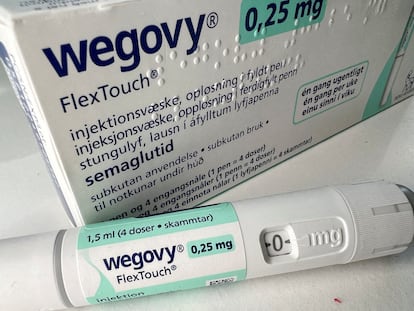‘Science’ names anti-obesity drugs the scientific breakthrough of the year
The journal highlights their reduction of cardiovascular incidents and the possibilities they create for treating conditions as diverse as addictions, Alzheimer’s disease and Parkinson’s disease
From cardiology journals to the cover of Science: all year, GLP-1 analogues — drugs used to treat diabetes and achieve weight loss — have been the talk of the town. It started with celebrities like Elon Musk and Oprah Winfrey speaking openly about taking them. The drugs sparked cultural debate around obesity, not as a moral issue or a lack of willpower but as a disease. Not since the days of Botox and Viagra has a medical treatment entered the collective imagination in this way. Then they jumped into the business pages. The two most popular commercial GLP-1 analogues, Ozempic and Wegovy, made their Danish manufacturer, Novo Nordisk, the most valuable company in Europe and saved Denmark from recession. Meanwhile, they have been a fixture in scientific journals, demonstrating their effectiveness for weight loss and reducing cardiovascular incidents. And as the year winds down, these drugs continue to populate the pages of important publications: Science magazine just selected GLP-1 analogues as the scientific breakthrough of 2023.
These drugs mimic the hormones that naturally make us feel satiated after eating. And they do it better for a longer period of time. While they have been prescribed since 2017, in recent years they have greatly expanded their effects. Semaglutide (a molecule marketed as Wegovy) can produce a 15% reduction in total weight; that’s an unheard-of percentage that’s never been achieved with medication before. “But perhaps the most important thing of all, beyond the weight loss itself, is that they are demonstrating a reduction in morbimortality,” says Juan José Gorgojo, the head of the nutrition at the Alcorcón Foundation University Hospital in Spain.
A study published this year has shown that these drugs reduce the risk of heart attacks and strokes by up to 20% in overweight people. “In addition, this same drug [semaglutide 2.4mg] has shown clinical benefits in patients with heart failure,” adds Dr. Gorgojo. ”That’s more than enough reason for it to be highlighted as one of the breakthroughs of the year.” The journal mentions that “two landmark clinical trials” show that these medications have demonstrated benefits “that go beyond weight loss.” What’s more, the unexpected side effects of GLP-1 analogs in modifying addictive behaviors in many patients have opened the door to possible future uses. Science notes that “there are currently several ongoing trials investigating their use in the treatment of drug addiction, Alzheimer’s disease and Parkinson’s disease.”
Science’s announcement comes a day after Nature, another leading scientific journal, chose biochemist Svetlana Mojsov, a key figure in the discovery of GLP-1, as one of its ten scientists of the year. Mojsov’s role is especially relevant to this story. First, her scientific contribution to these drugs was crucial: she identified and described the hormone and created the peptides on which these medications are based. But her story is also important because it demonstrates the patriarchal functioning of the scientific world. For years, industry journals and awards praised the work of Mojsov’s male peers, Drs. Daniel Drucker, Joel Habener and Jens Juul Holst, while systematically ignoring hers. Years later, the Serbian biochemist has finally achieved the recognition that she had previously been denied. Journals such as Cell and Nature that initially silenced her contributions have had to publish corrections to put her name on a par with those of her colleagues.
Costs and the rebound effect
Dr. Gorgojo says that, in the Spanish context, where GLP-1 agonists are only financed for cases of type 2 diabetes, the healthcare system should take note and start funding the treatment for patients with obesity and related problems. The difference is between paying 130 euros a week to about four euros a week. This will require significant public spending, the specialist acknowledges, but in the long run it could save money. Obesity is associated with over 200 diseases and cardiovascular problems, while complications from obesity account for 9.7% of total healthcare spending in Spain, according to the Organization for Economic Co-operation and Development.
The bad news is that this would not be a one-time expense but rather a constant one. “Obesity is a chronic disease,” says Gorgojo. “There is no treatment for a chronic disease that is used for [only] a few months. Treatment must be continued for life.” A recent clinical trial conducted with tirzepatide (an even more potent molecule marketed under the name Mounjaro) is a case in point. After 36 weeks of treatment, patients experienced an average weight loss of 20.9%. Then researchers stopped giving some of the patients the drug and replaced it with a placebo. This group regained 14% of the weight, while those who remained on the drug continued to lose up to 5.5% more in the following weeks. The rebound effect is pronounced and begins the moment use of the drug is discontinued.
Cristóbal Morales, an endocrinologist at the Virgen de la Macarena Hospital in Seville, Spain, and a prolific researcher in this field, highlights the ways in which these drugs have changed social perceptions of obesity. “The major change is that we have realized that it is a social disease,” he explains. “There’s a lack of evolutionary adaptation. We have prehistoric genes from the Pleistocene, and our [living situation] is not the same as it was then. We live in an obesogenic environment.” Old genes, coupled with our new environments, push us to overeat. Ultra-processed foods really work like designer drugs by releasing huge amounts of dopamine in our bodies, which are designed to react like this to the sugars and fat that are scarcer in natural foods. “The good thing is that science has advanced to provide an answer for this lack of adaptation, this metabolic deregulation,” says Morales.
Pharmacological treatment of this disease can be effective. But its visible effects cannot make us lose focus, says the expert. “This is not going to be fixed with drugs alone; we need the main revolution to be a change in society,” he points out. We must not look for an individual solution but a social and environmental one. According to the 2020 European Health Survey in Spain, 24% of people of low socioeconomic status are obese, while the prevalence is only 9% among people who have more resources. Obesity is a question of class, and the rise of these drugs — which will soon be available to everyone for a few hundred euros a week — only underscores that fact. For that reason, specialists are calling for these drugs to be understood as a tool to improve health, not aesthetics, and for scientific advances to be accompanied by a social and multifactorial approach.
Morales reflects that people “always need different pieces…to tell their story. And we were missing pieces to tell this story, pieces of epigenetics to understand why we are experiencing this pandemic.” Now that we have them, now that obesity is beginning to be understood as a social and environmental disease, and not the result of a weak character or a lack of willpower, we can begin to find solutions, the endocrinologist observes. As Science notes, 2023 has been the year of GLP-1 agonists. “I think 2024 will be the year of tackling the obesity problem and lowering the curve of complications from it,” Morales adds.
Sign up for our weekly newsletter to get more English-language news coverage from EL PAÍS USA Edition
Tu suscripción se está usando en otro dispositivo
¿Quieres añadir otro usuario a tu suscripción?
Si continúas leyendo en este dispositivo, no se podrá leer en el otro.
FlechaTu suscripción se está usando en otro dispositivo y solo puedes acceder a EL PAÍS desde un dispositivo a la vez.
Si quieres compartir tu cuenta, cambia tu suscripción a la modalidad Premium, así podrás añadir otro usuario. Cada uno accederá con su propia cuenta de email, lo que os permitirá personalizar vuestra experiencia en EL PAÍS.
¿Tienes una suscripción de empresa? Accede aquí para contratar más cuentas.
En el caso de no saber quién está usando tu cuenta, te recomendamos cambiar tu contraseña aquí.
Si decides continuar compartiendo tu cuenta, este mensaje se mostrará en tu dispositivo y en el de la otra persona que está usando tu cuenta de forma indefinida, afectando a tu experiencia de lectura. Puedes consultar aquí los términos y condiciones de la suscripción digital.
More information
Archived In
Últimas noticias
The new victims of the Republican war on Obamacare: Millions hit by soaring health insurance premiums
A country divided on migrant rights: Some US states expand protections while others restrict them
Venezuela authorizes the release of another 87 political prisoners
There is as much life left to discover on planet Earth as that which is already known
Most viewed
- David King, chemist: ‘There are scientists studying how to cool the planet; nobody should stop these experiments from happening’
- Reinhard Genzel, Nobel laureate in physics: ‘One-minute videos will never give you the truth’
- Oona Chaplin: ‘I told James Cameron that I was living in a treehouse and starting a permaculture project with a friend’
- Sinaloa Cartel war is taking its toll on Los Chapitos
- The Interoceanic Train, the Mexican alternative to the Panama Canal











































